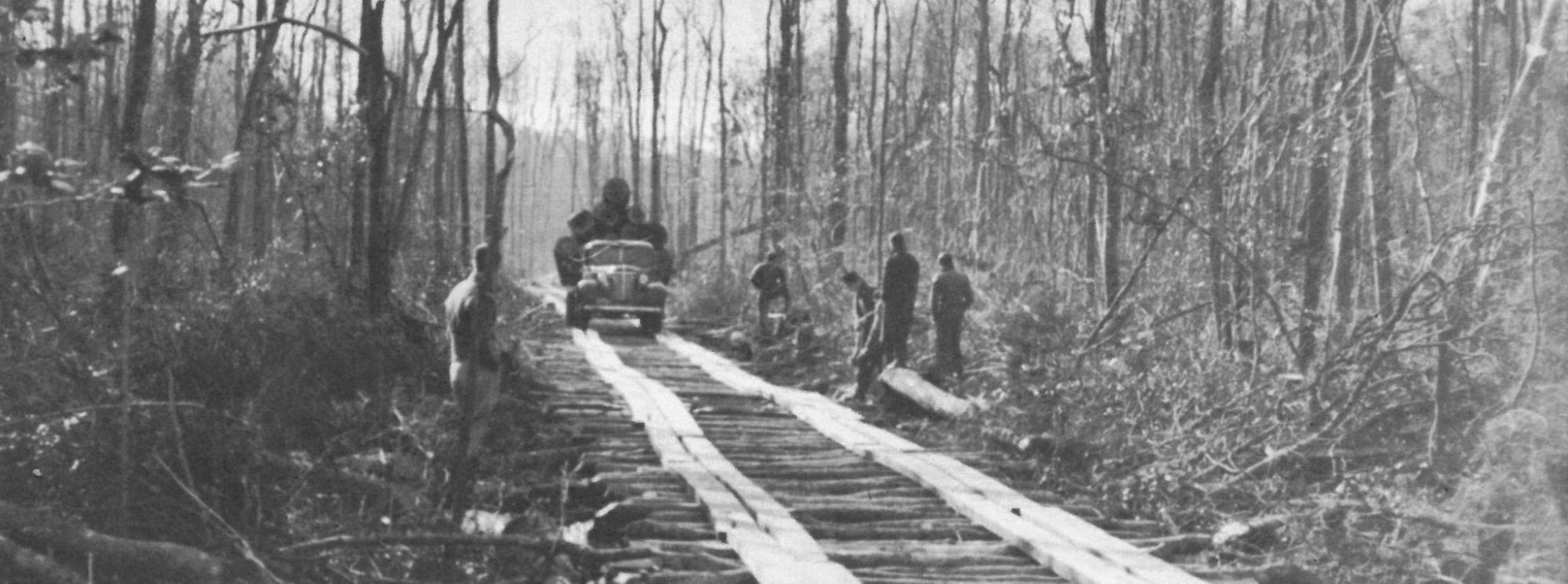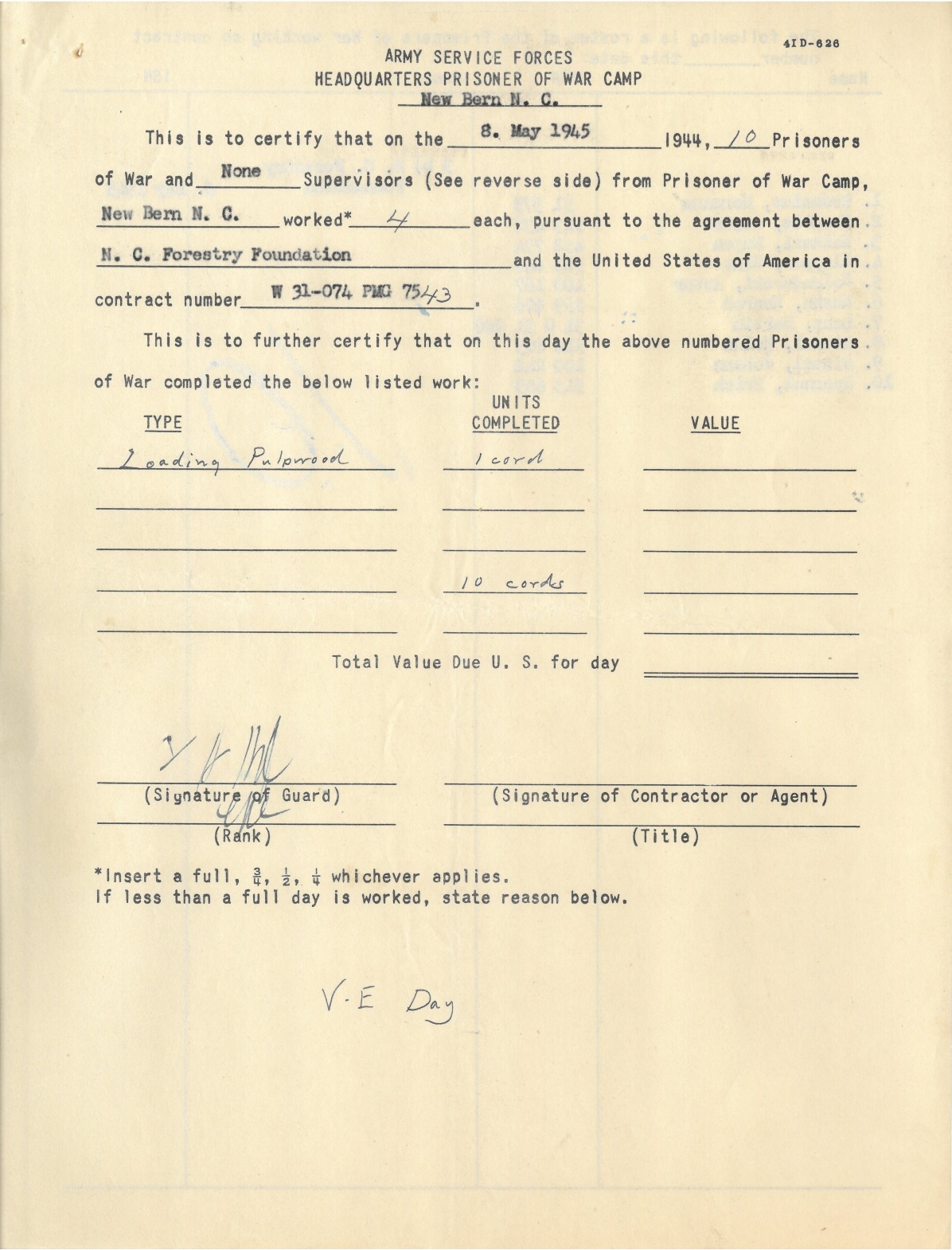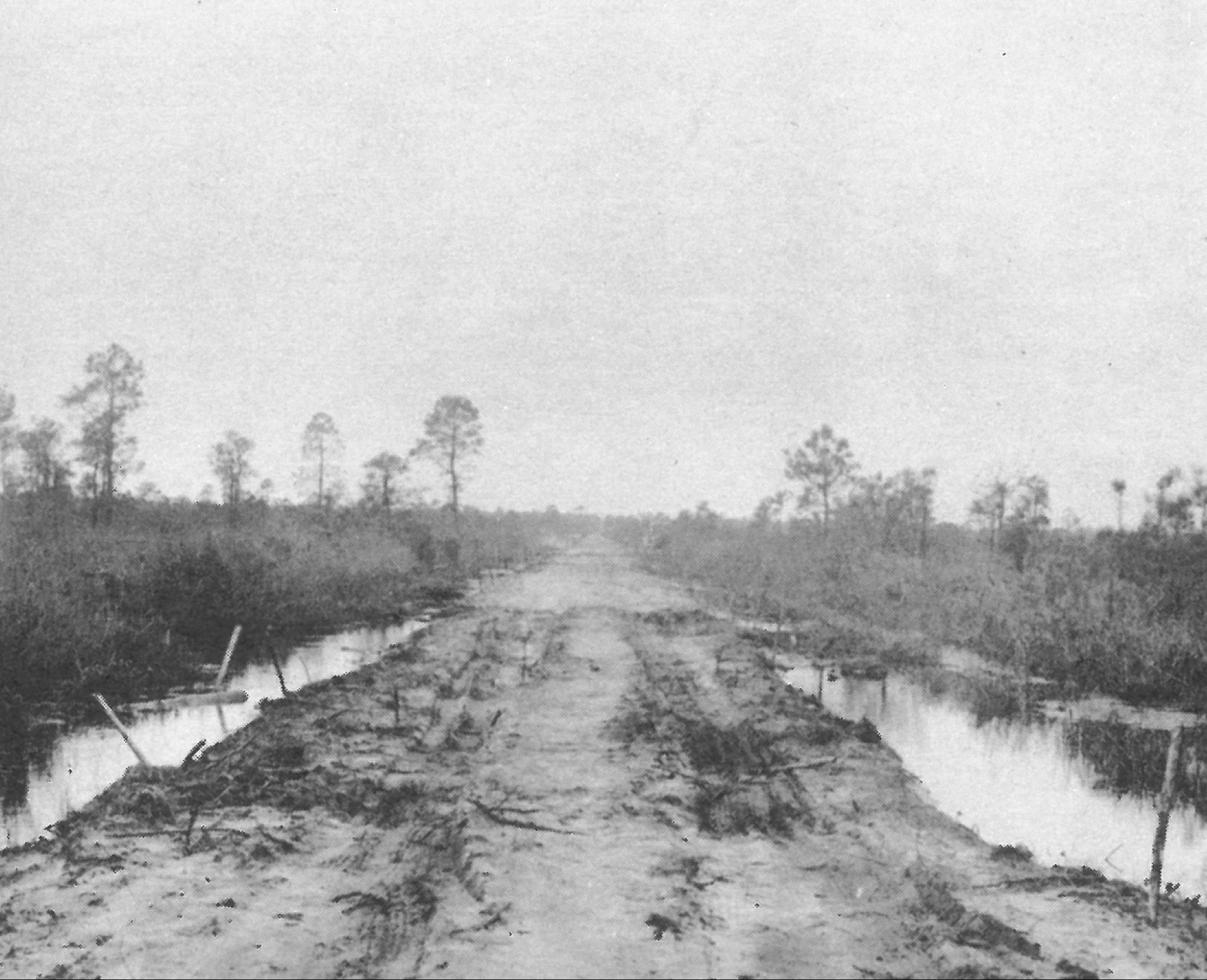
Men in Hofmann Forest loading veneer wood logs onto a truck, April 1945.
Blog post authored by Matthew Angel, Special Collections Desk Assistant, and edited by Taylor Wolford and Clara Wilson.
Hofmann Forest has long been a site of research and education for the College of Natural Resources, the NC Natural Resources Foundation, and the State of North Carolina. The acquisition of the property by Dr. Julius V. Hofmann and the fledgling NC Forestry Foundation (known today as the Natural Resources Foundation) helped kickstart NC State College’s Forestry program, one of the first in the nation. However, the purchase caused the Forestry Foundation to spend the first two decades of its existence on the brink of ruin due to the financial strain of maintaining and managing the expansive Hofmann Forest. Consequently, the Forestry Foundation managed to keep itself afloat through a variety of methods, including the use of captured Axis Prisoners of War (POWs) as a labor force in 1945.
Hofmann Forest is comprised of 79,000 acres of land spanning Onslow and Jones counties in eastern North Carolina. The forest is part of an area that was granted to David Allison, who was likely a North Carolina merchant, in 1795 (Hofmann Forest: A Narrative History of the North Carolina Forestry Foundation). It was formally acquired by Dr. Hofmann and the Forestry Foundation in 1934. During the Great Depression, without funding from the College or state to outright purchase the land, Dr. Hofmann negotiated a long-term payment schedule and devised a 10-year plan to settle the debt. The logging industry immediately made bids to purchase the logging rights to the land, but the Forestry Foundation was insistent that they independently manage the forest (The Hofmann Forest, A History of the North Carolina Forestry Foundation).
The Foundation quickly fell behind on its payments. In Hofmann Forest: A Narrative History of the North Carolina Forestry Foundation, Forestry Professor Dr. Robert C. Kellison recounted that “the especially lean financial years for the Foundation - 1935 to 1939, were a result of the lack of markets for forest products and timber-consuming wildfires.” Dr. Hofmann’s correspondence revealed that labor shortages compounded these issues, as there were neither enough hands to cut fire lanes and carve new infrastructure nor to harvest wood and run the sawmills. Of the wood that could be harvested, its sale price fell far short of expectations as demand hit rock bottom. Within its first decade of existence, the Forestry Foundation was in deep financial trouble.


In 1939, the Allison heirs, themselves strapped for cash and suffering the effects of the Great Depression, offered to substantially lower the purchase price of the land from $400,000 to $295,000 if the Forestry Foundation could pay off the debt immediately. To raise the money, the foundation sold hundreds of bonds, predominantly to surrounding lumber and paper companies. Dr. Hofmann, still confident that the Forestry Foundation was capable of handling the responsibility, promised to repay the investments with 75% of the profit from timber sales. A 1939 report by the Forestry Foundation Board of Directors lauded the treasure trove of timber in the forest and estimated that they would be able to more than double their net income to pay off the land within 10 years. However, the foundation’s financial situation became more dire after World War II broke out.

The war pulled a great portion of the U.S. working population out of the workforce, leaving labor shortages across the country, including at NC State College. In January 1945, Dr. Hofmann stated he had only 5 employees on the payroll: nowhere near enough to fill the foundation’s extensive contracts, not to mention their normal duties of managing the forest’s 79,000 acres.
The logging and paper companies that purchased bonds in Hofmann Forest became impatient with the Forestry Foundation’s unsuccessful efforts to pay off their debts. It was clear to all parties that the Forestry Foundation could not tap the natural resources of Hofmann Forest without tractors, trucks, and workers, but it simply could not afford them. Therefore, the bond holders advanced funds to pay for the necessary equipment and labor. In the absence of local workers, the Forestry Foundation explored wartime opportunities.

One such opportunity was foreign guest labor. In January 1945, Dr. Hofmann submitted a request to the Federal War Manpower Commission for 20 physically strong workers, preferably with logging experience. His request was granted in June when workers from Barbados arrived in the forest. However, there were immediate problems with the labor contract. The Barbadians did not expect their working conditions to be so harsh. After only two days in the forest they refused to work, citing the danger posed by wild animals, such as snakes, and the undeveloped terrain. Although the Barbadians eventually ended their strike after the British Consulate refused to take them back home, the Forestry Foundation found their half-hearted efforts were “not of the amount and quality that would justify the wages paid them” (UA 140.045 - Legal box 27, Folder 1). At the Foundation’s insistence, their contract was terminated by the end of the month and they were transferred to nearby industrial centers and sawmills.

Simultaneously, the Foundation explored the possibility of sourcing labor from Camp Battle, which was a POW camp nearby in New Bern. The federal government authorized a POW compulsory work program in 1944 and, for a fee, the labor of POWs was contracted by the hour. The Forestry Foundation entered into a POW labor contract with the War Department in February 1945, and the first POWs from Camp Battle arrived in Hofmann Forest in March of that year.

Thousands of German prisoners of war were detained in 18 camps throughout North Carolina during World War II. In 2017, New Bern’s Steve Tyson contacted the last known surviving POW that was imprisoned in Camp Battle, Georg Bachmeier. Bachmeier recalled the camp held about 150 prisoners spread across 10 wooden barracks, and every day many of those inmates worked on nearby cotton and tobacco farms or at a local butcher shop. Additionally, every day about a dozen men were selectively assigned to the work detail cutting pulpwood in Hofmann Forest. Beginning on March 28, 1945, the POWs' work in the forest was recorded in a daily work report, which are now part of the School Forest Records held by the Special Collections Research Center.
The daily reports logged hours worked and assessed prisoner productivity. Notes scribbled in the margins reflected the Forestry Foundation’s satisfaction or frustration with individual prisoners; some were praised for their work while others were recommended to never return. Interestingly, the POW labor reports indicate that the prisoners maintained military hierarchy on the work detail, with many reports showing that POW officers were formally appointed to serve as supervisors. The reports also reflected significant disruptions to the normal workflow, including rain, the German surrender on May 8, 1945 (VE Day), and a logging accident that cost one prisoner his thumb. Signatures on the reports indicate that Dr. Hofmann and his colleagues were often on-site to direct the efforts of the POWs.


Beyond a name and a serial number for each POW, the reports provided little information on who the POWs were and where they came from, although it is likely that most were captured in North Africa or parts of Europe, and many of the prisoners were likely German. Due to the lack of information in these reports, the treatment of the POWs in the Hofmann Forest is mostly left to interpretation. However, Georg Bachmeier (who was held in Camp Battle but never assigned to the Hofmann Forest detail) described his treatment favorably in a letter to Steve Tyson.

Although the production of pulpwood from the forest increased with the POW labor contract, the financial situation of the Forestry Foundation worsened. Due to wartime shortages of tractors and transport vehicles, and the swamp-like conditions of the forest and its roads because of unprecedented rainfall, the Foundation was unable to produce enough pulpwood and timber to sell. Worse still, the paper companies had not dispersed all of the funds promised to the Forestry Foundation for equipment and labor, plunging the foundation even further into debt. Eventually, the Forestry Foundation could no longer afford to pay the War Manpower Commission the leasing fee for the German POWs.
With some hostility from both parties, debt collectors from the Forestry Foundation were sent to the paper companies and debt collectors from the paper companies were sent to the Foundation, while the bank struggled to mediate and find a solution. In the absence of funding from the paper companies, Dr. Hofmann sought to minimize the financial damage by canceling the POW contract. However, this brought scorn from the bond holders, particularly the President of the Albemarle Paper Company, who accused Dr. Hofmann of incompetency and remarked that, “it would seem to us that (continuing the POW labor) is the only way of having any hope of meeting the minimum guaranteed delivery” (UA 140.045 - Box 4, Folder 2).

The POWs continued to work in the forest until October 1945, and by December, all German POWs returned to Europe. In 1946, the Forestry Foundation’s debt became insurmountable, and the foundation sold the forest’s logging rights to the Halifax Paper Company in a 99-year lease, except for a small portion reserved for research. It wasn't until 1983 that all the significant debts had been resolved, and the land was finally paid off.
If you are interested in viewing Special Collections materials, please contact us at library_specialcollections@ncsu.edu or submit a request online. The Special Collections Research Center is open by appointment only. Appointments are available Monday–Friday, 9am–6pm and Saturday, 1pm–5pm. Requests for a Saturday appointment must be received no later than Tuesday of the same week. Please note that Special Collections will be closed December 22nd through January 6th for winter break. Regular operations will resume the week of January 8t.
NC State University Libraries Special Collections Research Center:
North Carolina State University, College of Natural Resources, School Forests Records 1869-2016. UA 140.045.
University Archives Photograph Collection, Agricultural Extension and Research Services Photographs 1900-1992. UA 023.007.
University Archives Photograph Collection, People Photographs 1890-1999. UA 023.024.
Historical Context, History of Forestry (An NC ECHO Project). 2010. https://www.lib.ncsu.edu/specialcollections/forestry/background.html
Other Sources:
Robert C. Kellison, Harold C. Blanchard, and Glenn P. Catts. 2011. Hofmann Forest: A Narrative History of the North Carolina Forestry Foundation, 1970-2008.
William D. Miller. 1970. The Hofmann Forest: A History of the North Carolina Forestry Foundation.
William D. Miller, Walter M. Keller, and Eric L. Ellwood. 1979. School of Forest Resources, 1929-1979, A History.
Foundation. College of Natural Resources. https://cnr.ncsu.edu/giving/foundation/
Forests and Facilities. NC State College of Natural Resources. https://cnr.ncsu.edu/about/forests-facilities/
Robert Kellison. NC State College of Natural Resources. https://cnr.ncsu.edu/directory/robert-c-kellison/
Robert D. Billinger Jr. and Jo Ann Williford. Prisoners of War Held in North Carolina. NCpedia, 2006. https://www.ncpedia.org/printpdf/3968
Bill Hand. Tyson finds last survivor of New Bern POW camp. Sun Journal, Nov 9, 2019. https://www.newbernsj.com/news/local/tyson-finds-last-survivor-of-new-bern-pow-camp/article_18657caf-bcf3-5450-a9b5-faace5cc66e4.html